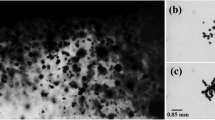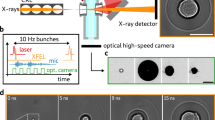Abstract
An abiding issue in cavitation science is the focusing of energy by the collapse of a gas bubble in water. In particular, one would like to understand the origin of the flash of light ('sonoluminescence') that accompanies bubble collapse1. Hilgenfeldt et al.2 have presented a simple explanation for this light emission, based on a hydrodynamic (Rayleigh–Plesset) analysis of bubble dynamics. Here we argue that their model is too simple, on the grounds that it cannot account for some well-established observations and that it involves the application of this hydrodynamic equation outside its range of validity.
This is a preview of subscription content, access via your institution
Access options
Subscribe to this journal
Receive 51 print issues and online access
$199.00 per year
only $3.90 per issue
Buy this article
- Purchase on Springer Link
- Instant access to full article PDF
Prices may be subject to local taxes which are calculated during checkout
Similar content being viewed by others
References
Barber, B. P. et al. Phys. Rep. 281, 65–144 (1997).
Hilgenfeldt, S., Grossman, S. & Lohse, D. Nature 398, 402–405 (1999).
Temple, P. R. Sonoluminescence from the Gas of a Single Bubble. Thesis, Univ. Vermont (1970).
Zeldovich, Y. B. & Raizer, Y. P. Physics of Shock Waves and High-Temperature, Hydrodynamic Phenomena Vols 1, 2 (Academic, New York, 1967).
Wu, C. C. & Roberts, P. H. Phys. Rev. Lett. 70, 3424–3427 (1993).
Hiller, R. A. et al. Science 265, 248–250 (1994).
Hilgenfeldt, S., Grossman, S. & Lohse, D. Phys. Fluids 11, 1318–1330 (1999).
Löfstedt, R., Barber, B. P. & Putterman, S. Phys. Fluids A 5, 2911–2928 (1993).
Putterman, S. Phys. World 11, 38–42 (1998).
Weninger, K., Evans, P. G. & Putterman, S. Phys. Rev. E 61, 1020–1023 (2000).
Putterman, S. & Weninger, K. Annu. Rev. Fluid Mech. 32, 445–476 (2000).
Vazquez, G. & Putterman, S. Phys. Rev. Lett. 85, 3037–3040 (2000).
Peterson, F. B. & Anderson, T. P. Phys. Fluids 10, 874–879 (1967).
Hickling, R. Phys. Fluids 11, 1586–1587 (1968).
Vasquez, G., Camara, C., Putterman, S. & Weninger, K. Los Alamos preprint server 0009057.
Author information
Authors and Affiliations
Corresponding author
Rights and permissions
About this article
Cite this article
Putterman, S., Evans, P., Vazquez, G. et al. Is there a simple theory of sonoluminescence?. Nature 409, 782–783 (2001). https://doi.org/10.1038/35057317
Issue Date:
DOI: https://doi.org/10.1038/35057317
This article is cited by
-
Physical model of energy activation of anode microarc oxidation
Journal of Engineering Physics and Thermophysics (2009)
Comments
By submitting a comment you agree to abide by our Terms and Community Guidelines. If you find something abusive or that does not comply with our terms or guidelines please flag it as inappropriate.



